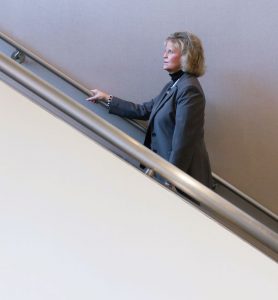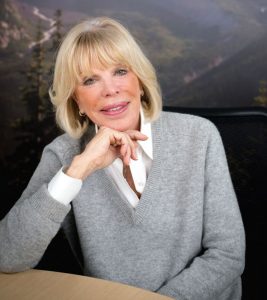
Women are making their mark, and they’re doing it in highly technical positions.
TW Special Report
Randy Rubin is co-founder and vice chairman of Crypton, a Bloomfield Hills, Mich.-based fabric manufacturer. She takes distinct pride in pointing out that on any given day, most of us will likely sit on a fabric she helped create.
“I’m willing to bet that if you go to a mall, restaurant, hotel, nursing home or hospital waiting area, you’re going to be sitting on Crypton, and I get so excited when I know I’m sitting on our technology!”
But Rubin doesn’t take her success lightly. In the early ‘90s, Rubin and her husband started their company out of the basement of their home. He invented Crypton, a heavy-duty, stain-resistant fabric that doesn’t look heavy-duty. She figured out how to patent and brand it, but they needed someone to manufacture the fabric.
“There was not one woman in sight,” Rubin said of one of their first factory visits. “We went to the mill, and all of the executives were men.”
Still, Rubin managed to cut a deal to have their first fabric produced. From there, she soared.
Since that early factory visit, Rubin’s company has grown by leaps and bounds. Crypton has manufacturing operations in North Carolina; today it holds 25 different patents and has sold more than 150 million yards of Crypton fabric. It also acquired Nanotex®, a leading fabric innovation company, and recently was named best in innovation at the International Textiles Alliance (ITA) awards gala.
“We invented this fabric and had very little money, but we were gutsy. We always say that we were never both scared on the same day,” Rubin said.

Today, the brainchild of Rubin and her husband is still one of the most innovative brands in the textile industry.
She says she may have been a fish out of water when they got started, but Rubin believes they helped change the industry for the better. “We created a reason why the American mills could get Made-in-America business by only licensing American mills to use our technology.
We became an important part of their business because they had a protected brand to sell,” she said.
While Rubin was a bit of a pioneer, women in leadership positions are increasingly common within the broader textile industry.
Dr. Nancy Cassill is one such example. In 2000, she was the first female full professor recruited into North Carolina State University’s College of Textiles, one of the world’s premier textile research institutions.
Now associate dean for academic programs – another first for a woman – Cassill says there are more women coming to the college looking to get into the textile industry than ever before. In fact, 72 percent of the college’s student population was female in 2016, compared to just 43 percent in 1998.
Several reasons explain the uptick.
One is the college’s focus on pre- and post-production areas of design, brand marketing, new product development and global sourcing. Another is its work to build stronger partnerships industry-wide.
As part of this effort to mold America’s next generation of talented textile makers, Cassill helped create the nation’s only bachelor of science degrees in fashion and textile management and fashion and textile design. She also established the college’s Industry Advisory Board, composed of 22 textile executives, and currently is working to create a new Student Life Center to nurture student leadership and career development.
But Cassill also believes women are drawn to the industry’s growing emphasis on product diversification in apparel, home/furniture, industrial and more.
“I think there’s real strength in females who have a great aesthetic and innovative ideas. Females make the majority of textile-related purchases in the home, and I think women contribute a great understanding of market and consumer purchasing and buying patterns.”
As for the future?
“I think the heritage of the industry is male dominated. That’s changing, but there’s a lot of work still to be done; that’s why we’re strengthening academic programs, to turn out people who are well prepared, and to appeal to students from a variety of backgrounds.”
And Cassill says women in the industry are strong leaders. “There are several who are truly viewed as strategic thinkers, and I think they’re great role models for all of our students.”

Amber Brookman is one of those role models. She says women look at the world differently than men and believes that’s served her well in her role as CEO of Brookwood Companies Inc., one of America’s most technically advanced textile companies and a substantial supplier of diverse woven and nylon products to the United States military.
Brookman manages close to 500 employees between the company’s headquarters in New York and its manufacturing operations in Connecticut and Rhode Island. “Textiles are interesting because they take a massive amount of technical knowledge to do them well.”
Nevertheless, Brookman admits she sort of fell into the industry. She was a top model who appeared on TV and runways, attended the Academy Awards and even played tennis with Barbara Streisand. Then, at age 30, she decided to go in a different direction. “As far as opportunities for women in the couture industry, you had salesmen and you had showroom girls, and I never wanted to be anyone’s girl!”
A referral and a knock-em-dead interview helped her land a fashion director job for a company called Allied Chemicals.
“They made nylon yarn. I didn’t know anything about it, but they hired me anyway. I went from being a model to having a secretary and an office, and I wasn’t sure what to do with either of them. But Allied was a great place to work and financially supported my higher education at New York University.”
She became an expert in her field. Within a few years, a customer offered her a new job opportunity, where Brookman would open a division for the design and marketing of sports-related textiles.
“One thing led to another, and I wound up taking control of the entire company. That company was Brookwood.
“We have a unique hiring policy that hires people for what they bring to the table. You have to be smart, nice and work hard. You have to have talent and brains. I don’t need good old boys.
“That’s a woman’s perspective.”
She said she has carved out her own niche as a woman running a huge company in the textile industry.
“The fascinating part about being a CEO is that you have to provide the vision that helps the company stay successful through good times and bad — and that is an art, not a science. You have to really care about what happens to the company and put the good of the company and its employees first.”
Editor’s Note: This article appears in Textile World courtesy of the National Council of Textile Organizations (NCTO) as part of the “American Textiles: We Make Amazing™” campaign. NCTO is a trade association representing U.S. textile manufacturing. Please visit ncto.org to learn more about NCTO, the industry and the campaign.
November/December 2017




